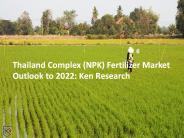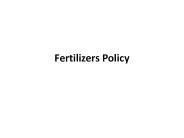Nitrogenous Fertilizer PowerPoint PPT Presentations
All Time
Recommended
Unit 31 Nitrogenous fertilizers & sulphuric acid
| PowerPoint PPT presentation | free to view
Nitrogenous Fertilizer Market Size, Share Analysis, Growth And Forecast 2024-2033
| PowerPoint PPT presentation | free to download
Nitrogenous Fertilizers Report by Material, Application, and Geography Global Forecast to 2021 is a professional and comprehensive research report on the worlds major regional market conditions, focusing on the main regions North America, Europe and Asia-Pacific and the main countries United States, Germany, United Kingdom,Japan, South Korea and China.
| PowerPoint PPT presentation | free to download
The nitrogenous fertilizer market can be bifurcated on the basis of its ingredients that include nitrate, ammonium, urea, amine and others. Urea-based nitrogenous fertilizers have been the most dominant product segment in terms of consumption. Globally, Technological Advancement, Rising demand for automobile industry the developing nations are the prime growth drivers of global Nitrogenous Fertilizer market.
| PowerPoint PPT presentation | free to download
The nitrogenous fertilizer market was valued at US$ 72,537.57 million in 2018 and is expected to grow at a CAGR of 3.7% from 2019 to 2027 to reach US$ 100,304.42 million by 2027.
| PowerPoint PPT presentation | free to download
The global nitrogenous fertilizer market size grew from $67.21 billion in 2022 to $71.02 billion in 2023 at a compound annual growth rate (CAGR) of 5.7%.
| PowerPoint PPT presentation | free to download
A recent report published by Precision Business Insights on Nitrogenous Fertilizers Market provides in-depth analysis of segments and sub-segments in the global as well as regional.
| PowerPoint PPT presentation | free to download
The nitrogenous fertilizer market was valued at US$ 72,537.57 million in 2018 and is expected to grow at a CAGR of 3.7% from 2019 to 2027 to reach US$ 100,304.42 million by 2027.
| PowerPoint PPT presentation | free to download
The market for nitrogenous fertilizers is projected to reach USD 127.00 Billion by 2022, at a CAGR of around 2.33% from 2016. The global nitrogenous fertilizers market has grown exponentially in the last few years. Need to increase productivity and level yield and fertilizer intensity gaps across regions, rise in awareness regarding soil profile, and nutritional balance backed by state support are the major drivers for the market.
| PowerPoint PPT presentation | free to download
Global Nitrogenous Fertilizers Market 2023 is an extensive, professional analysis bringing market research data which is pertinent to new market entrants and recognized players. The report covers data that makes the record a resource for analysts, managers, Nitrogenous Fertilizers industry experts as well as important people to get self-analyze along with ready-to-access study together side graphs and tables. Mixing the information integration and research capacities with the findings, this Nitrogenous Fertilizers report has forecast the strong rise of this market in product sections and every geography.
| PowerPoint PPT presentation | free to download
Avail more information from Sample Brochure of report @ http://bit.ly/2s47vIw The China Nitrogenous Fertilizer Market Research Report Forecast 2017-2021 is a valuable source of insightful data for business strategists. It provides the Nitrogenous Fertilizer industry overview with growth analysis and historical & futuristic cost, revenue, demand and supply data (as applicable). The research analysts provide an elaborate description of the value chain and its distributor analysis. This Nitrogenous Fertilizer market study provides comprehensive data which enhances the understanding, scope and application of this report. Read report analysis @ http://bit.ly/2qrtet2
| PowerPoint PPT presentation | free to download
The publication also includes trade scenario, Trend and developments and future analysis of Thailand complex fertilizer market with estimated production and consumption projections has also been discussed along with analyst recommendations.. For more information on the research report, refer to below link: https://www.kenresearch.com/agriculture-and-animal-care/crop-protection/thailand-complex-fertilizer-market/143970-104.html
| PowerPoint PPT presentation | free to download
The overall nitrogenous fertilizer market is calculated by subdividing or segmenting the market into micro-markets, based on the share of each application, product, and geographical region.
| PowerPoint PPT presentation | free to download
This comprehensive publication enables readers the critical perspectives to be able to evaluate the world market for nitrogenous fertilizers. The publication provides the market size, growth and forecasts.
| PowerPoint PPT presentation | free to download
DecisionDatabases.com adds a report on Global Nitrogenous Fertilizers Industry 2015 Market Research Report. This research study is segmented on the bases of applications, technology and geography.
| PowerPoint PPT presentation | free to download
The industry research publication titled ‘Indonesia Fertilizer Industry Outlook to 2017 – Escalating Usage of Organic Fertilizers’ presents a comprehensive analysis of market size by volume of fertilizers in Indonesia. The report entails the market share analysis and company profiles of major players in the fertilizer industry.
| PowerPoint PPT presentation | free to download
Nitrogen fertilizers have traditionally been favored by farmers in Europe as it is best suited to its topography and climate. France is the biggest consumer of nitrogenous fertilizers among the European region. In Germany, the Nitrates Directive has been implemented, which sets detailed and precise legal requirements for good agricultural practices with regards to the application of nitrogenous fertilizers.
| PowerPoint PPT presentation | free to download
The industry research publication titled ‘Vietnam Fertilizer Industry Outlook to 2017 – Government Initiatives to Enhance NPK Complex Fertilizer Growth’ presents a comprehensive analysis of market size by volume of fertilizers in Vietnam. The report entails the market share analysis and company profiles of major players in the fertilizer industry.
| PowerPoint PPT presentation | free to download
This report provides a comprehensive analysis of the various aspects such as market size, segmentation, trends and developments and future projections of the fertilizer industry of major countries in Asia which includes China, India, Indonesia, Thailand, Vietnam, Japan, Philippines, South Korea and Malaysia. The fertilizer industry in Asia majorly comprised of various three major macro nutrients namely nitrogen, phosphate and potash fertilizers and their different products in Asian countries.
| PowerPoint PPT presentation | free to download
Fertilizers are mixtures of chemical products containing nitrogen, phosphorus, potassium and other necessary nutrients. Minerals are essential nutrients for survival of all plants, naturally provided through soil or man-made sources such as fertilizers. Naturally occurring minerals are gradually washed out of soil due to various reasons such as soil erosion and continuous extraction of mineral components by the plant. Therefore, fertilizers are used to re-supply proper amount of nutrients in the soil to maintain optimal plant growth. Agricultural fertilizers are available in solid, liquid as well as in gaseous form for cultivation of plants in farms. Use of fertilizers in the farms increases the production and farm income.
| PowerPoint PPT presentation | free to download
An organic fertilizer company is a business that specializes in the production and distribution of fertilizers made from organic materials. Organic fertilizers are derived from natural sources such as plant and animal waste, compost, and other organic matter. These fertilizers are rich in essential nutrients, including nitrogen, phosphorus, and potassium, which are necessary for plant growth and development.
| PowerPoint PPT presentation | free to download
Promotes growth of leaves and stems. Gives dark green color and improves quality of ... Animal Tankage. Organic vs. Inorganic. Advantages of Organic Fertilizers ...
| PowerPoint PPT presentation | free to view
Note Preview of bio - Fertilizer on PPT
| PowerPoint PPT presentation | free to download
Fertilizers Chapter 14 Scott s Starter Fertilizer Scott s Turf Builder Fertilizers A materials applied to soil or plants to provide essential elements.
| PowerPoint PPT presentation | free to view
FERTILIZER MANAGEMENT Fertilizer These are the inorganic sources of nutrients, which supply one or more nutrients Why fertilizer is needed? Need at vegetative phase ...
| PowerPoint PPT presentation | free to download
Plant growth is accelerated by organic fertilizers. This goal is accomplished through two methods, the most common of which is the addition that adds nutrients. The second way that different fertilizers work is to change the soil's water retention and aeration to increase its potency. Composts regularly provided, in shifting extents. There are numerous categories for organic fertilizers. They are categorized according to whether they supply a single nutrient; if so, they are referred to as "straight fertilizers." Two or more nutrients are provided by "Multinutrient fertilizers." Organic fertilizers and inorganic fertilizers are also sometimes used to describe fertilizers. The following section discusses the advantages of organic fertilizers and artificial fertilizers.
| PowerPoint PPT presentation | free to download
All fertilizers are labeled with three numbers giving the ... All other ingredients are considered and called filler. COMPLETE VERSUS INCOMPLETE FERTILIZERS ...
| PowerPoint PPT presentation | free to view
Fertilizers & Nutrients By: Johnny M. Jessup Agriculture Teacher/FFA Advisor Essential Plant Nutrients Macronutrients Required in relatively large amounts.
| PowerPoint PPT presentation | free to view
Fertilizer is a superb lawn fertilizer formulated to quickly provide a deep green and healthy lawn. Furthermore, details about hi yield fertilizer or to place an order, visit our official site at Statewide Service Center.
| PowerPoint PPT presentation | free to download
According to the latest research report by IMARC Group, The global fertilizer market size reached US$ 176.4 Billion in 2023. Looking forward, IMARC Group expects the market to reach US$ 236.9 Billion by 2032, exhibiting a growth rate (CAGR) of 3.2% during 2024-2032. More Info:- https://www.imarcgroup.com/fertilizer-market
| PowerPoint PPT presentation | free to download
According to the latest research report by IMARC Group, The global liquid fertilizers market size reached US$ 14.4 Billion in 2022. Looking forward, IMARC Group expects the market to reach US$ 17.6 Billion by 2028, exhibiting a growth rate (CAGR) of 3.27% during 2023-2028. More Info:- https://www.imarcgroup.com/liquid-fertilizers-market
| PowerPoint PPT presentation | free to download
Chapter 5 SOIL AND FERTILIZER N * * * * * * * * * * * * * * * * * * * * * * * * * * * * * * * * * * * * * * * * * * * * * * * * * * * * * * * * * * * * * * * NH3 pH 7 ...
| PowerPoint PPT presentation | free to download
... Material Tonnes Nutrient N Straight nitrogenous fertilizers Ammonium sulphate 21 % N 2153 452 Calcium ammonium nitrate 26 % N 587 153 Urea 46% N 3286 ...
| PowerPoint PPT presentation | free to download
Global fertilizer additives market is registering a steady CAGR of 3.60% in the forecast period of 2019-2026
| PowerPoint PPT presentation | free to download
The Business Research Company offers nitrogen fertilizer market research report 2023 with industry size, share, segments and market growth
| PowerPoint PPT presentation | free to download
Global fertilizer additives market is registering a steady CAGR of 3.60% in the forecast period of 2019-2026.
| PowerPoint PPT presentation | free to download
Plants need significant amounts of nitrogen, phosphorus, and potassium to grow and thrive. The Natural ways to add NPK fertilizers to soil are easy, cost-efficient, and even healthier for your plants. To know how to add NPK Fertilizer to the soil, visit www.otolawn.com
| PowerPoint PPT presentation | free to download
The Indian fertilizer industry has played a pivotal support role in the Indian agricultural industry. The growth in the use of chemical fertilizers amongst the farmers has been the secret of nation’s green revolution in the late of sixties. The main fertilizer used in the state includes nitrogenous fertilizers, phosphate fertilizers, potash fertilizers and complex fertilizers. Today India is the third largest producer and second largest consumer in the field of fertilizers in the world. The fertilizers industry is distributed between three major participants’ viz. Private sector undertakings, public sector units and cooperative societies. The Government of India subsidizes fertilizers to ensure that fertilizers are easily available to farmers and the county remains self-sufficient in agriculture and food grain production. Read more at: http://www.researchbeam.com/india-chemical-fertilizers-outlook-2021-market
| PowerPoint PPT presentation | free to download
Bharat Book Bureau provides the report, on " Liquid Fertilizers Market by Type, Mode of Application, Form, Crop Type, and Region - Global Forecast to 2021”. The market drivers include growing demand for high efficiency fertilizers, ease of use and application, adoption of precision farming and protected agriculture, and increasing environmental concerns. https://www.bharatbook.com/materials-chemicals-market-research-reports-783146/liquid-fertilizers-type-application-form-region-global-forecast.html
| PowerPoint PPT presentation | free to download
Fertilizers Market size is forecast to reach $202.89 million by 2026 after growing at a CAGR of 4.5% during 2021-2026. Global nutrient demand, poor economic outlook, depressing crop prices, increasing market pressure, and unpredictable energy prices; are the prime factors fueling the demand of fertilizers. Further, presence of limited arable land with ever-increasing food demand due to rise in population has put pressure to increase food productivity, which resulted in increased usage of fertilizers.
| PowerPoint PPT presentation | free to download
Farming and gardening is not an easy thing. Most importantly, it takes time and patience to use the best products for the plants and crops for their growth and well-being. One of the nuisances that crops and plants tend to face is pests and insects. They can cause diseases and can damage fruits and plants. In this world of natural fertilizers and microbial supplements,.
| PowerPoint PPT presentation | free to download
According to the latest report by Renub Research, titled “Biological Organic Fertilizers Market Global Forecast 2021-2027, Industry Trends, Share, Insight, Impact of COVID-19, Opportunity Company Analysis” the Global Biological Organic Fertilizers Market will be US$ 3.1 Billion by 2027. Nowadays, in developing intensive agriculture globally application of chemical fertilizers is the most adopted system. However, the continuous long-term use of chemical fertilizer has led to many unexpected effects. Hence, biological organic fertilizers in recent years have been considered an alternative source for soil, water, and crop-contaminating chemical fertilizers to have the potential to enhance soil productivity and plant growth in a sustainable agriculture worldwide.
| PowerPoint PPT presentation | free to download
The global fertilizer market was valued at $357 billion in 2017. Asia Pacific was the largest region in the fertilizer market in 2017
| PowerPoint PPT presentation | free to download
NPK stands for nitrogen, phosphorus, and potassium and all soil needs NPK. All plants need a healthy amount of NPK in order to grow. For your healthy lawn, know how to add NPK Fertilizer to the soil, visit www.otolawn.com
| PowerPoint PPT presentation | free to download
Soil Nutrients and Fertilizers 24.00: Explain the role of nutrients in quality plant growth Macro vs Micro Nutrients Macro nutrients are required by the plant in ...
| PowerPoint PPT presentation | free to download
Discover the art of DIY organic fertilizers. Learn the process of crafting nutrient-rich compost at home, fostering healthier plants and sustainable gardening practices effortlessly.
| PowerPoint PPT presentation | free to download
Fertilizer Additives Market size is forecast to reach US$ 1.7 billion by 2026, after growing at a CAGR of 3.5% during 2021-2026.
| PowerPoint PPT presentation | free to download
The best organic fertilizer for plants and flowers helps through: Nitrogen (N) which is good for the growth of leaves Phosphorus (P) which is good for roots strengthening Potassium (K) which is good for the formation of fruits and flowers of a plant.
| PowerPoint PPT presentation | free to view
Fertilizer Additives Market size is forecast to reach US$ 1.7 billion by 2026, after growing at a CAGR of 3.5% during 2021-2026. Fertilizer additives are chemicals that are used to prevent the loss of important macro and micronutrients such as nitrogen, phosphorus, potassium, calcium, manganese, and iron from fertilizers.
| PowerPoint PPT presentation | free to download
All soil needs NPK and the rest of the blend depends on your soil’s specific chemical makeup. NPK stands for nitrogen, phosphorus, and potassium. Plants need significant amounts of NPK to grow and thrive. To know the importance of NPK In Soil, visit www.otolawn.com
| PowerPoint PPT presentation | free to download
Fertilizer Additives Market size is forecast to reach US$ 1.7 billion by 2026, after growing at a CAGR of 3.5% during 2021-2026.
| PowerPoint PPT presentation | free to download
Global Water Soluble Fertilizers Market - (By Applications - Fertigation, Foliar. By Product Types [ Get Sample Report Now At: http://tinyurl.com/hmrkp86 ] - Nitrogenous Water Soluble Fertilizers, Phosphatic Water Soluble Fertilizers, Potassic Water Soluble Fertilizers, Other Water Soluble Fertilizers (Micronutrients), Biofertilizers, Biostimulants and By Region). Global Industry Analysis, Size, Share, Growth, Trends, and Forecast, 2014 - 2021
| PowerPoint PPT presentation | free to download
Managing Fertilizer Inputs Prepared for 2006 Extension Agent Update, Conrad by Clain Jones, Extension Soil Fertility Specialist clainj@montana.edu; 406 994-6076
| PowerPoint PPT presentation | free to view
Fertilizer Additives Market size is forecast to reach US$ 1.7 billion by 2026, after growing at a CAGR of 3.5% during 2021-2026.
| PowerPoint PPT presentation | free to download
























































